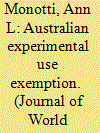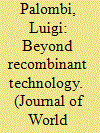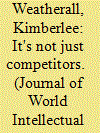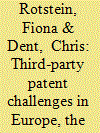|
|
|
Sort Order |
|
|
|
Items / Page
|
|
|
|
|
|
|
| Srl | Item |
| 1 |
ID:
090973


|
|
|
|
|
| Publication |
2009.
|
| Summary/Abstract |
Australian patent law contains no express exemption from infringement for any experimental use of patented inventions. A variety of international and local events became catalysts for two extensive reviews in Australia of the existence of and need for some form of exemption from infringement for experimental and research use of patented inventions. One was conducted as part of a larger investigation by the Australian Law Reform Commission (ALRC): Genes and Ingenuity: Gene Patenting and Human Health. The second was a specific investigation into patents and experimental use by the Advisory Council on Intellectual Property (ACIP). Its final report Patents and Experimental Use was published in 2005. Both reports recommended that the Commonwealth government should amend the Patents Act 1990 to establish an exemption (ALRC) or exception (ACIP) from patent infringement for certain acts involving experimental use of patents. However, while the former Howard liberal government chose to accept the ACIP recommendation in 2007, the new Rudd labour government has not introduced any amendment to date. This article provides a brief overview of the recommendations of those reviews and evaluates the current position in Australia in both the light of the reviews and of subsequent international developments
|
|
|
|
|
|
|
|
|
|
|
|
|
|
|
|
| 2 |
ID:
090967


|
|
|
|
|
| Publication |
2009.
|
| Summary/Abstract |
Even though it is not yet clear as a matter of law that isolated biological materials are indeed patentable subject matter, patents over such materials continue to be granted throughout the world. Recently, Craig Venter, the man who wanted to patent the human genome, made history again. This time he has built a synthetic bacterium from the ground up-in a laboratory. The bacterium, Mycoplasma genitalium, is a naturally occurring thing. It is the smallest known bacterium consisting of 582,970 nucleotides. Venter's version of this bacterium is identical, except that he made it. Does this make it an invention? Indeed, Venter has in mind to use this synthetic bacterium, and other synthetic biological materials, as plasmids within which to insert genetic material that is foreign to that organism. The idea is to use these plasmids to manufacture other biological materials. It is a repeat of Cohen and Boyer's idea, which they also patented, but this time the plasmid itself will be a human construct. Is the patent system ready for Venter and his "invention"?
|
|
|
|
|
|
|
|
|
|
|
|
|
|
|
|
| 3 |
ID:
090974


|
|
|
|
|
| Publication |
2009.
|
| Summary/Abstract |
This article discusses New Zealand's approach to experimental use of patents. The article focuses on the current proposal to include an experimental use provision in the patent legislation. The history of such an exception in the common law is examined. The article concludes that the introduction of an experimental use exception has been discussed in isolation of what is the best economic and research policy outcome for New Zealand. In particular, questions are raised as to who would use the exception and what research would it attract to New Zealand. The present lack of an experimental use exception has not had the effect of increasing patent-related research in New Zealand. Therefore, the author suggests that, overall, an experimental use exception could be a good thing, but the research benefits need to be discussed more fully. Also any exception needs to be carefully crafted in a way that the current proposal, adopted from an Australian proposal, is not
|
|
|
|
|
|
|
|
|
|
|
|
|
|
|
|
| 4 |
ID:
090963


|
|
|
| 5 |
ID:
090980


|
|
|
|
|
| Publication |
2009.
|
| Summary/Abstract |
In patent, institutional design matters, and goals matter to institutional design. This article concerns the institutional design of mechanisms that can be used by third parties to challenge the validity of proposed or granted patents in the patent office-oppositions, revocations and similar processes. This article traces the various goals of these mechanisms, and how those goals have changed over time. It argues that recent economic and legal literature, which has influenced proposals for reforming these systems, is altogether too neat and tidy, treating public interest participants as interfering busybodies. It is better to acknowledge and embrace groups like Peer to Patent and the Public Patent Foundation, and think about how, in the long term, we can adjust aspects of the patent system to incorporate public input without too much sacrifice to politics and uncertainty.
|
|
|
|
|
|
|
|
|
|
|
|
|
|
|
|
| 6 |
ID:
090971


|
|
|
|
|
| Publication |
2009.
|
| Summary/Abstract |
In this article I suggest that a forgotten value of the patent law system is freedom of expression. Vestiges can be found in the law's allowance for exhibition of unpatented inventions under provisions whose history can be traced back to the great exhibitions of the nineteenth century. The provisions' initial purpose may have been to preserve an inventor's ability to patent an invention at a time when exhibition was the dominant norm and patenting relatively limited. But, for various reasons to be explored in the article, patenting has now emerged as the dominant norm. When it comes to reform of patent law, if anything, I argue, the law could expand the freedom to exhibit. There may be some net benefits to be obtained in terms of supporting and driving innovation. However, the benefit most especially associated with exhibitions lies in the collective enjoyment of the spectacle-as flourished in the medieval markets and fairs long before the patent system emerged as a mechanism to permit and regulate monopolies, found a measure of official support in the nineteenth- and twentieth-century museums, galleries and exhibitions, and is now being rediscovered again in certain newer forms of public display of the twenty-first century.
|
|
|
|
|
|
|
|
|
|
|
|
|
|
|
|
| 7 |
ID:
090965


|
|
|
|
|
| Publication |
2009.
|
| Summary/Abstract |
This article considers the impact of the Agreement on Trade-Related Aspects of Intellectual Property Rights (TRIPS) in developing countries. After an initial phase of "paper compliance" with TRIPS, followed by efforts to manage the welfare costs of its implementation, a number of developing countries are looking at ways to optimize the implementation or reimplementation of the agreement to foster domestic competitiveness and innovation. One part of the equation involves attracting technology-intensive foreign direct investment. Another involves enhancing local innovation potential. Surfing the wave of outsourcing, which increasingly targets higher knowledge functions, a number of developing countries are becoming globally competitive innovators and displacing the geographical centres of innovation, with substantial political and economic impacts.
|
|
|
|
|
|
|
|
|
|
|
|
|
|
|
|
| 8 |
ID:
090984


|
|
|
|
|
| Publication |
2009.
|
| Summary/Abstract |
Specialization in intellectual property law has, in recent years, become an important issue due to the need for an efficient system for the resolution of intellectual property and patent disputes. Specialist courts or panels within existing courts have been developed in many jurisdictions and the question posed in this article is whether New Zealand should follow suit. This article traverses the differing specialist intellectual property (IP) and patent adjudication systems in the United States, United Kingdom, Australia and Japan to assess what system would best suit New Zealand. The benefits and disadvantages of specialization generally are also discussed. The conclusion is that the time is ripe for some form of specialization in IP matters in New Zealand and that the best model for New Zealand to adopt is one similar to that of the Federal Court of Australia panel system, whereby judges opt into particular panels while still taking on cases within the court's general docket. The article proposes that this specialization in New Zealand should occur in the High Court (trial level) as the real need for specialist knowledge is at the fact-finding stage. It is argued that a panel system would strike the appropriate balance between developing expertise on the bench, allowing for cross-fertilization of legal developments, while also preventing stagnation and idiosyncratic interpretations of the law. Some specialization at intermediate appellate court level is also recommended.
|
|
|
|
|
|
|
|
|
|
|
|
|
|
|
|
| 9 |
ID:
090976


|
|
|
|
|
| Publication |
2009.
|
| Summary/Abstract |
Third parties are now playing a key role in the processes leading to the grant, and validation, of patents. This article looks at the key differences between three systems of third-party challenge, which have the common goal of providing patentees and their competitors with a forum, other than the courts, where issues of patent validity may be challenged and resolved. Those systems are post-grant opposition before the European Patent Office, pre-grant opposition in Australia and re-examination in the United States. Various aspects of the systems are looked at, including an overview of the procedures, avenues of appeal and statistics on their use. Insufficient empirical evidence is available to permit a comprehensive assessment of which system is the most effective; however, the data available do allow some conclusions to be drawn-including the suggestion that one reason for the differences in levels of use of the three systems may be the perceptions of US Patent and Trademark Office examiners and the culture that has built up within the US patent attorney profession. The degree of divergence in the three systems further indicates that more work needs to be carried out if reforms to the procedures are to be based on need rather than supposition.
|
|
|
|
|
|
|
|
|
|
|
|
|
|
|
|
|
|
|
|
|